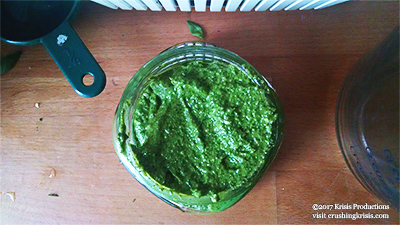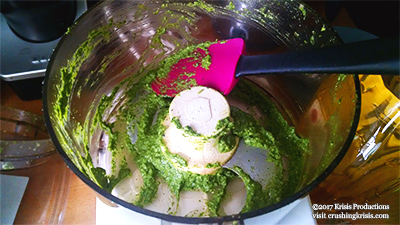I don’t remember the first time I had pesto, but it is one of my favorite things to add to any food.
 Pasta. Salmon. Shrimp. Toast. Eggs. Chips dipped directly into it. Pesto makes everything better. It’s also pretty much an entire spinach salad in every few spoons, which is how I help justify how quickly I can consume it compared to the amount of cheese and oil it contains.
Pasta. Salmon. Shrimp. Toast. Eggs. Chips dipped directly into it. Pesto makes everything better. It’s also pretty much an entire spinach salad in every few spoons, which is how I help justify how quickly I can consume it compared to the amount of cheese and oil it contains.
I clearly recall having it at the appropriately-named Ristorante Pesto on Broad Street as a teenager, but that seems like such a late point in life to have tasted pesto for the first time.
Thus, while I wish I could say this is an old family recipe, it’s not – it’s just adapted from The Better Homes and Gardens cookbook over the course of dozens of trials over the course of the past decade. It used to be that E made it and then I just greedily consumed it. Finally, I became impatient about waiting for her to decide she felt like making pesto and so I made it myself and realized it is so easy to do (as long as you have a decent food processor).
Now I make double and triple batches every time so I can enjoy as much pesto as I want on my pasta and everything else.
Here is the ingredient list for an 8oz batch of pesto, which is probably enough to toss with for pasta for four. I use the alterations in parenthesis every time, but they make things more complex – you’ll do just fine ignoring them your first time.
- 1 & 1/2 cups baby spinach, tightly packed
- 1/4 cup fresh basil, tightly packed
- 1/4 cup grated romano cheese (or, split evenly w/parmesan)
- 1/4 cup olive oil
- 1/4 cup pine nuts (or, split evenly with slivered almonds)
- 1 tablespoon of minced garlic (I use jarred; if fresh, use up to 3 cloves adding gradually and tasting)
- optional pinch of salt (very little – less than 1/16 of a teaspoon)
 Honestly, if you just throw that all into a food processor with no rhyme or reason you’d still wind up with good pesto.
Honestly, if you just throw that all into a food processor with no rhyme or reason you’d still wind up with good pesto.
For those of you who like a little more specificity to your recipes than that:
- add ingredients from the bottom up except for the salt and half of each the oil and the garlic
- give your food processor several light three-second pulses with each addition
- your goal is for the nuts to be a paste before getting to the greens
- add the remainder of the oil along with the spinach; your goal is for the spinach to not be liquified
- tasted your handiwork; add the remaining garlic and optional salt to taste
The flavors should be relatively balanced, but these are all ingredients that can vary with each purchase. If the garlic note isn’t overpowering, add your remainder. If it’s not cheesy enough, add more cheese. If it’s not “wet” enough, try more pine nuts before adding more oil. If it’s not enough of any taste, add more basil and the pinch of salt. If it’s too much every taste, try adding a handful more spinach to neutralize.
Toss fresh with pasta or store for up to a week in the refrigerator. If you make a large batch, freeze your extra pesto in ice cube trays – it will store in the freezer indefinitely. Microwave for 20-30 seconds to make it into a spreadable paste again.
And now, for my annotated ingredient list, from bottom to top.
- optional pinch of salt (very little – less than 1/16 of a teaspoon)
I’ve made this recipe many times without any salt at all. The cheese has a lot of salt in it. The only reason I’ll add a pinch is if I reach the end of the recipe and realize I’ve added more cheese and basil multiple times – that’s usually a hint that it needs a pinch of salt to bring out the flavors.
- 1 tablespoon of minced garlic (I use jarred; if fresh, use 1/2 tablespoon and add gradually)
Every so often I convince myself I am a gourmet Italian chef who would never use minced garlic from a jar and use fresh garlic … and every time I do that my pesto comes out too garlicky and I have to add more of almost every other ingredient.
If you really don’t want to use jarred garlic, (a) you must be chopping garlic every four hours, because I used it in just about every single thing I cook and (b) start out with just one clove and add the rest at the end very gradually.
- 1/4 cup pine nuts (or, split evenly with slivered almonds)
I used to go with all pine nuts, but one time Gina brought over pesto she made with almonds and it tasted so very rich. After that I’ve gone half-and-half pine nuts and slivered almonds, and I feel like the pesto has more body. Also, pine nuts are crazy expensive here, so this makes the recipe a lot cheaper to make in bulk.
- 1/4 cup olive oil
Of all the things I am an Italian snob about, olive oil surprisingly isn’t one. Virgin or light will do – here’s an educational post about the difference. Just don’t get cute and substitute another kind of oil, okay?
- 1/4 cup grated romano cheese (or, split evenly w/parmesan)
I find that using just one type of sharp, grated cheese tends to allow the cheese to overwhelm the flavor profile of the pesto. It isn’t supposed to be a cheese paste – it shouldn’t really have any one ingredient stick out. A blend of two sharp cheeses helps the pesto have more amplitude (i.e., a single taste without notes that stick out).
- 1/4 cup fresh basil, tightly packed
E swears by the version of this recipe that uses dried basil and her pesto is maybe slightly more amazing than mine, but I have never got it right with dried basil. Substitute at your own peril.
- 1 & 1/2 cups baby spinach, tightly packed
I’ve tried this twice recently with non-baby spinach – so, I guess, adult spinach? – and the recipe came out tasting like soggy spinach. I think if you are totally religious about drying out your fresh spinach and pulling off the stems it could work, but I find that baby spinach comes out better every time.
I’m sorry…I don’t understand the phrase “too garlicky”…
ME NEITHER. But some members of the household apparently have a garlic threshold.